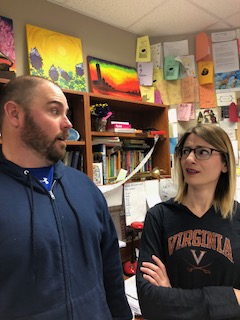
This past summer I took advantage of an extraordinary opportunity. I mentioned it in my first ever blog post and my thoughts about that experience are unwavering. The Summer Institute reinforced some of my already held readers/writers workshop beliefs and clarified many others.
One experience was particularly profound. Meggie Willner and I found it so evocative that we based an entire professional learning presentation around it that we presented at our district Profession Learning Day in August and even submitted a similar presentation for consideration at TCTELA this year. Unfortunately, we weren’t selected for TCTELA, but Meggie and I still talk about how much this lesson taught us and how we still reach back to that lesson as this year moves forward.
On Day 7 of the institute, Amy presented us with a piece called “The Cactus,” by O’Henry. I’m not intimately familiar with O’Henry’s works, but Meggie is and her opinion is a favorable one. Amy took us through the exercise of discovering the beautiful language and writer’s moves that exist in the piece and we shared our thoughts and “workshopped” the text the way we should with our students.
At some point, Amy stated that this was a text we needed to present to our STAAR Camp students and Meggie and I simultaneously turned to each other in fear.

Our initial thoughts were identical. We knew our students very well and we knew that this text was far too difficult for them to conquer. Meggie and I weren’t sure that we could shepherd them through this text and as soon as the session ended, we hustled up to our classroom to find something with which we were more comfortable and something we felt would engage the kids.
We quickly found a story called “Checkouts,” that was both easier to dig through and thematically similar to “The Cactus,” and away we went. The lesson went beautifully, the students engaged with the story and we were able to guide them through discovering the writer’s moves and the thematic ideas in the text. Meggie and I both agreed that we made the right decision for our kids.
Early on Day 8 Amy said something to the effect of: “I noticed many of our teacher teams chose not to use “The Cactus” in their lessons yesterday and went with texts that were less complex.” (I’m paraphrasing this because I don’t remember the exact words Amy used, but I remember feeling my face turn red and Meggie and I slow-turning to each other with matching looks of horror.)

Amy continued her thought by telling us how important the complexity of the text was to our readers and how texts that our kids would encounter on the STAAR test would match the complexity of “The Cactus.”
As soon as that morning’s session ended, we scurried up to our classroom with our tails between our legs and sat down to develop a plan to present “The Cactus” to our students.
We planned the activities that are typical of workshop to go with this piece. We drafted questions that we thought might prompt their thinking and help them engage the text. We looked at the text with an eye towards anticipating the places they would struggle with the language. Looking back, we prepared well for this lesson.
Our preparation paid off when the students dug into the text. If you haven’t read “The Cactus,” please take my word for it that there are many difficult to understand words and this is what made us feel apprehensive. To our great joy, a piece that we thought would stump them turned out to be accessible and engaging and they found insight and nuance in its words. They floored us!!!
We discovered something too: our idea to present them first with “Checkouts” provided a scaffold to “The Cactus.” They were able to digest the complexity of the more difficult text because they were comfortable and familiar with its thoughts and themes. They trusted us because we built that relationship with the more easily accessible text. They learned that they don’t have to have understanding of every single word in the text to experience mastery of the text. They can still engage in the nuance of theme and voice and other important skills. Once they found success engaging “The Cactus,” we could see their confidence build and they were able to enjoy the text in the same way as the adults in the room; as readers.
This is such an important lesson for me to learn. Often, I take for granted that the students will engage with a text or just assume that they won’t. My thinking, instead, should be about I can move them into a text by using what they already know or what they are interested in. This may be obvious to other teachers, but I’m not a trained reading and writing teacher and I still have many lessons to learn.
Charles Moore still can’t figure out how to stay off of Amazon.com on snow days. He is currently reading Warcross by Marie Lu and Truly Devious by Maureen Johnson and keeps his eyes open for suggestive cacti. His almost daily musing can be found on his twitter page @ctcoach

[…] Charles wrote about scaffolding a reading lesson. The same type of lesson, but with an eye toward reading like a writer, worked recently with my […]
LikeLike
The photos of you and Meggie have me on the floor. I love you guys!
Your message is a great one for us all. Thank you for sharing!
LikeLiked by 1 person
Those are authentic recreations based on the true story!!!
LikeLiked by 1 person